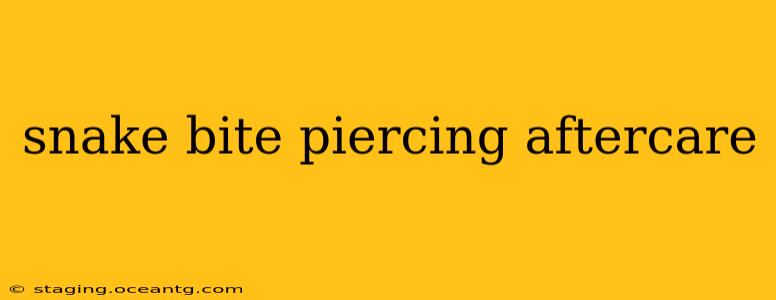Getting a snake bites piercing is a commitment, not just to a cool look, but also to diligent aftercare. This piercing, featuring two symmetrical piercings on the lower lip, is undeniably stylish, but requires careful attention to detail to ensure proper healing and prevent complications. Ignoring aftercare can lead to infection, rejection, or other unpleasant outcomes. This guide provides a comprehensive overview of snake bites piercing aftercare, addressing common questions and concerns.
What is the healing time for a snake bites piercing?
The healing time for snake bites piercings typically ranges from 6 to 12 months. However, this is just an estimate. Individual healing times vary depending on factors like your body's natural healing ability, adherence to aftercare instructions, and overall health. Some individuals might heal faster, while others may experience a longer healing process. Complete healing means the piercings are no longer tender, there's no more discharge, and the surrounding skin is healthy and smooth.
How do I clean a snake bites piercing?
Cleaning your snake bites piercing correctly is paramount to prevent infection. Follow these steps twice a day, morning and night:
- Wash your hands: Thoroughly wash your hands with antibacterial soap before touching your piercings.
- Rinse: Gently rinse the piercings with a saline solution (you can buy this at most pharmacies, or make your own by dissolving 1/4 teaspoon of non-iodized salt in 8 ounces of warm distilled water). Avoid using tap water, as it can contain impurities.
- Cleanse: Using a clean cotton swab or gauze, gently clean the area around each piercing, removing any crust or debris. Be sure not to tug or twist the jewelry.
- Dry: Pat the area dry with a clean paper towel. Avoid using cloth towels, as they can harbor bacteria.
Important Note: Avoid using harsh soaps, alcohol, hydrogen peroxide, or antibiotic ointments. These products can irritate the delicate skin and hinder the healing process.
What are the signs of a snake bites piercing infection?
Recognizing the signs of infection is crucial for timely intervention. Seek immediate professional medical attention if you experience any of the following:
- Increased pain and swelling: Beyond the initial discomfort, significantly increased pain and swelling are warning signs.
- Pus or thick yellow/green discharge: This indicates an infection.
- Redness and warmth around the piercing: These are common indicators of inflammation and potential infection.
- Fever or chills: These are systemic signs of infection and require immediate medical attention.
Can I change my snake bites jewelry before it's fully healed?
No, absolutely not. Changing your jewelry before the piercings are fully healed significantly increases the risk of infection and can lead to complications like rejection or migration. Wait until your piercer deems the piercings fully healed before considering a jewelry change. This usually means waiting the full 6-12 months mentioned earlier.
What should I avoid while my snake bites piercing heals?
During the healing process, avoid the following:
- Touching or playing with your piercings: This can transfer bacteria and irritate the area.
- Kissing: Avoid kissing until the piercings are fully healed to prevent the transfer of bacteria.
- Smoking: Smoking reduces blood flow, hindering the healing process and increasing infection risk.
- Alcohol: Excessive alcohol consumption can also impair your body's healing ability.
- Spicy or acidic foods: These can irritate the piercing site and cause discomfort.
- Sharing drinks or utensils: Avoid sharing drinks or utensils with others to prevent the spread of bacteria.
How long does it take for snake bites swelling to go down?
Swelling is a common occurrence immediately after a snake bites piercing and usually subsides within a few days to a couple of weeks. However, some minor swelling might persist for longer, especially during the initial healing stages. If the swelling is excessive, persistent, or accompanied by other signs of infection, consult your piercer or a medical professional.
Following these aftercare guidelines diligently will increase your chances of a smooth and successful healing process. Remember, patience is key. If you have any concerns or questions during the healing process, don't hesitate to contact your piercer or a healthcare professional. Proper aftercare is the best way to ensure your snake bites piercings look fantastic and remain healthy.
